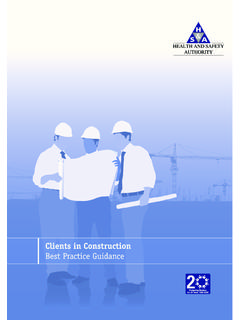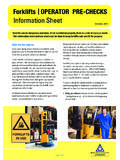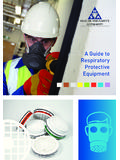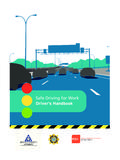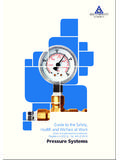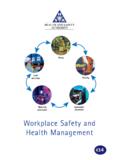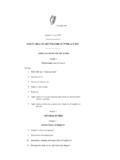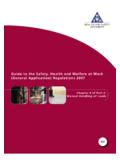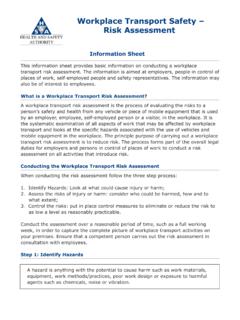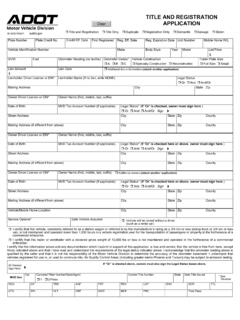Transcription of MOBILE ELEVATED WORK PLATFORMS (MEWPs) - Health and …
1 MOBILE ELEVATED WORK PLATFORMS (MEWPs)Guidance on Safe Operating ProceduresGuidance on the Safety, Health and Welfare at Work (Reporting of Accidents and Dangerous Occurrences) Regulations 2016 Our Vision:healthy, safe and productive livesPage 1 Cyan 100%Magenta 76%Y ellow 0 Black 27%Introduction ..2 What is a MEWP? ..2 Legal provisions ..2 Risk assessment ..3 Working near or over water ..3 Working on live roads ..3 Safe system of work ..3 Personnel Protective Equipment (PPE) ..3 Selecting the type of MEWP to be used ..4 Controlling and managing the risks ..5 Transport, delivery and collection ..5 Hiring a MEWP ..6 Storage or recharging ..7 Positioning of a MEWP ..7 Safe traffic management plan ..8 Working at heights ..9 Falling from a height ..9 How to carry out the work at height task correctly ..9 Operator awareness ..11 Incorrect operation ..11 Trapping or crushing ..11 Handling materials ..12 Avoiding electrocution ..13 Training.
2 13 Maintenance ..14 Thorough examination ..14 Further information ..14 ContentsPublished in 2017 by the Health and Safety Authority, The Metropolitan Building, James Joyce Street, Dublin 1. All rights 2 MOBILE ELEVATED Work PLATFORMS (MEWPs)Cyan 100%Magenta 76%Yellow 0 Black 27%Guidance on safe operating proceduresIntroductionThis guidance document has been prepared to assist those working with MOBILE ELEVATED Work PLATFORMS (MEWPs). It offers guidance on the following MEWP types: Static Vertical - for example, Scissors lifts (static), vertical personnel PLATFORMS (static) Static Boom - for example, Self-propelled booms (outriggers), vehicle mounted PLATFORMS MOBILE Vertical - for example, Scissors lifts ( MOBILE ), vertical personnel PLATFORMS ( MOBILE ) MOBILE Booms - for example, Self-propelled boomsPlease note the guidance does not cover non-integrated working PLATFORMS (also known as safety baskets or man cages); and it does not provide complete guidance for all MEWP is a MEWP?
3 A MEWP is a MOBILE machine. It is used to move persons to working positions where they are carrying out work from the work platform, with the intention that persons are getting on and off the work platform only at access positions at ground level or on the chassis. It consists at a minimum of a work platform with controls, an extending structure and a chassis. Legal provisionsThe legal provisions governing MEWPs are contained in the: Safety, Health and Welfare at Work Act 2005, Safety, Health and Welfare at Work (General Application) Regulations 2007 (particularly Chapter 2-Use of Work Equipment and Part 4-Work at Height), European Communities (Machinery) Regulations 2008 [ of 2008], and Safety, Health and Welfare at Work (Construction) Regulations 2013 Risk assessmentBefore carrying out any work at a height, a comprehensive site specific risk assessment should be carried out by a competent person. This should clearly identify all risks involved when using the MEWP and the measures needed to eliminate or control those risks.
4 Particular attention should be given to planning travel to and from the work area, accessing the work area, lighting (to aid good visibility), and carrying out the work task at a height. Ensure the risk assessment is communicated effectively to all relevant persons and, where necessary, it should be reviewed near or over waterWhen working near water or over water a detailed risk assessment needs to be carried out to ascertain the risk of drowning. If the risk of drowning is greater than the risk of falling from a height from the MEWP, then it is important to consider carefully whether or not it is appropriate to wear a harness (in certain circumstances it may be more appropriate to wear life jackets).Working on live roadsWhen working near live roads (for example, when erecting signage on motorways) a detailed risk assessment needs to be carried out. This should identify the most suitable MEWP for the task and the means of transport and delivery (See section on Controlling and Managing the Risks).
5 Safe system of workBased on the risk assessment, it is important to adopt a safe system of work for performing work tasks to ensure the work is done safely. The safe system of work including the rescue plan should be communicated effectively to all workers involved and within the vicinity of the works. All managers and supervisors should be familiar with all aspects of the system. They should also review and revise the system as work progresses and instruct staff accordingly. The rescue plan should be practised as part of the review Protective Equipment (PPE)Where appropriate and following a comprehensive risk assessment, personal protective equipment should be worn by MEWP operators. The following is a non-exhaustive list of PPE: A hard hat (with a chin strap where appropriate) Suitable safety footwear Suitable high visibility vest or jacket Suitable clothing for cold or wet weather conditions Hearing protection Eye protection Hand protection Page 3 Cyan 100%Magenta 76%Yellow 0 Black 27% Full body harness with a short restraint type lanyard which can be connected to designated anchor points in the basket to prevent a fall from the working platform where risk assessment must be completed by a competent person, taking account of the manufacturer s instructions, to determine what type of fall arrest or fall restraint (where applicable) is required to be used while operating a MEWP.
6 Generally for boom type MEWPs a full body harness with a short restraint type lanyard will be required to protect the worker from being catapulted out of the machine in the event of a boom swing, jolt or tilt. The lanyard must be anchored on a designated anchor point within the lift or scissor lift type MEWPs are unlikely to be affected by the same type of swings and jolt movements of the boom type the type of MEWP to be usedPre-planning is essential before choosing to use a MEWP. First, examine if the work can be done at ground level as this will eliminate the risk of working at height. If this is not possible then the following is a non-exhaustive list of issues to consider before deciding on the type of MEWP to be used: (1) The nature of the work. (2) The working environment that the MEWP will be operating in, particularly Will it be used on a construction site where there are other work activities taking place and workers present?
7 Will it be used on a motorway project or public road? Will it be used for maintenance work from time to time? Will it be used indoors or outdoors? What are the ground conditions or work surfaces like? Soft, rough, solid, poured, finished etc. What is the structural capacity of the ground that the MEWP will operate on? Will it be expected to travel in the ELEVATED position? Will refuelling on site be necessary? (3) The space available at the workplace to position and operate the MEWP, particularly, what height and outreach are necessary? Also are there overhead structures which could lead to trapping or crushing injuries, or overhead electricity lines which could lead to electrocution?Page 4 MOBILE ELEVATED WORK PLATFORMS (MEWPs)Guidance on Safe Operating ProceduresPage 5 Cyan 100%Magenta 76%Yellow 0 Black 27% (4) The safe working load (SWL) of the MEWP. (5) The number of people to be lifted by the MEWP.
8 (6) Whether or not the MEWP will be used for lifting persons tools and equipment, and if so how this can be done safely? (See section on handling materials). (7) Will material handling devices need to be used? Controlling and managing the risks When the most appropriate MEWP for the work has been selected, the next requirement is to manage the risks associated with its use. It is important to follow the manufacturer s instructions when using the MEWP. The following is a non-exhaustive list of issues that should be addressed:Transport, delivery and collection Ensure a safe traffic management plan is in place when loading and unloading the MEWP from the depot onto the delivery truck and similarly when removing the MEWP from the workplace. Ensure exclusion zones are in place and only use trained and experienced personnel to carry out specific tasks. Consider other hazards when carrying out loading and unloading procedures of the MEWP, including work at height; load securing, crushing; slips, trips and falls; and the environment that MEWP is being delivered to (for example are there other factors such as weather conditions, traffic, overhead lines, lack of maneuvering space and members of the public which need to be taken into consideration).
9 Ensure the delivery truck and associated equipment are suitable for the MEWP being transported. Carry out a pre-delivery inspection and have it documented, and ensure a competent person inspects the condition of the MEWP when it has been delivered to the site. Ensure that the MEWP carries a CE mark and a copy of the Declaration of Conformity (Certificate of Conformity) is available from the supplier. Ensure that the delivery driver is familiar with the particular MEWP being transported. Where familiarisation is required upon delivery ensure that the familiarisation is conducted to relevant trained site operators accordingly. Ensure the relevant maintenance and service records of the MEWP are up to date and available upon request from the rental company. Page 6 MOBILE ELEVATED WORK PLATFORMS (MEWPs)Guidance on Safe Operating Procedures Ensure there is a written pre-operational checklist for the MEWP. This can be found in the manufacturer s manual.
10 Ensure that all pre-operational checks are undertaken and recorded. Any defects or faults must be reported immediately to the supervisor and the MEWP should not be used. It should be tagged out of service and the keys removed until the defects have been corrected. Ensure that the delivery documentation and familiarisation documents (where required) are signed by the relevant personnel and dated at time of delivery and a MEWPThe majority of MEWPs are hired out from hire companies. The following is good practice for hire companies and contractors prior to selecting the most appropriate MEWP for the specific work practice for Hire Companies Establish what tasks the MEWP will be used for by the customer, for example will it be for one specific task or a range of tasks? It could be beneficial to offer an on-site assessment to select the right MEWP. Establish how the MEWP will be transported from the hire company s premises to the required location?
